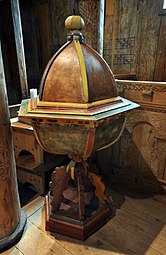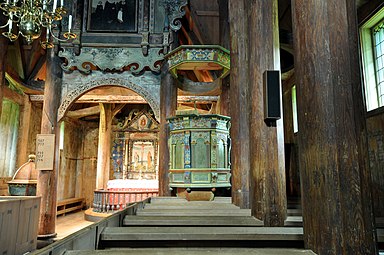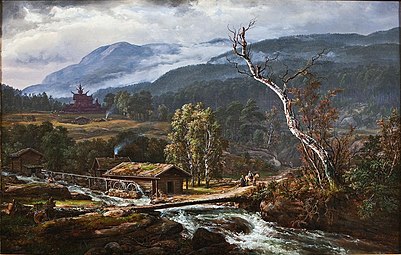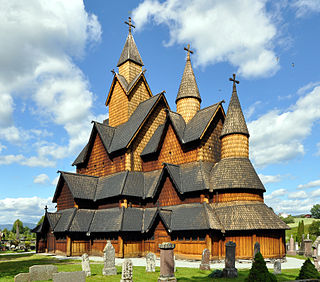
Heddal Stave Church is a parish church of the Church of Norway in Notodden Municipality in Telemark county, Norway. It is located in the village of Heddal. It is the church for the Heddal parish which is part of the Øvre Telemark prosti in the Diocese of Agder og Telemark. The wooden, triple nave stave church was built in a long church design around the year 1200 using plans drawn up by an unknown architect. The church seats about 180 people.

Borgund Stave Church is a former parish church initially of the Catholic Church and later the Church of Norway in Lærdal Municipality in Vestland county, Norway. It was built around the year 1200 as the village church of Borgund, and belonged to Lærdal parish until 1868, when its religious functions were transferred to a "new" Borgund Church, which was built nearby. The old church was restored, conserved and turned into a museum. It is funded and run by the Society for the Preservation of Ancient Norwegian Monuments, and is classified as a triple-nave stave church of the Sogn-type. Its grounds contain Norway's sole surviving stave-built free-standing bell tower.

Øye Stave Church is a parish church of the Church of Norway in Vang Municipality in Innlandet county, Norway. It is located in the village of Øye. It is one of the churches for the Øye parish which is part of the Valdres prosti (deanery) in the Diocese of Hamar. The brown, wooden stave church was built in a long church design in 1965 using plans drawn up by the architect Ole Øvergaard using pieces salvaged from the old 12th century church that had originally been torn down in 1747. The church seats about 30 people.

Lom Stave Church is a parish church of the Church of Norway in Lom municipality in Innlandet county, Norway. It is located in the village of Fossbergom in the traditional district of Gudbrandsdal. It is the church for the Lom parish which is part of the Nord-Gudbrandsdal prosti (deanery) in the Diocese of Hamar. The brown, wooden stave church was built around the year 1170 using plans drawn up by an unknown architect. The church seats about 350 people.
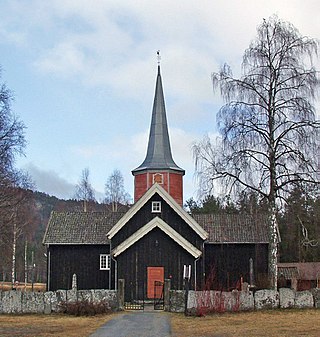
Flesberg Stave Church is a stave church located at Flesberg in Buskerud county, Norway.

Urnes Stave Church is a 12th-century stave church at Ornes, along the Lustrafjorden in the municipality of Luster in Vestland county, Norway.

Hopperstad Stave Church is a historic parish church of the Church of Norway in the village of Vikøyri in Vik Municipality in Vestland county. It was historically the church for the Hopperstad parish in the Diocese of Bjørgvin. The church is currently owned by the Society for the Preservation of Ancient Norwegian Monuments. The brown, wooden stave church was built during the 12th century. The church seats about 30 people.
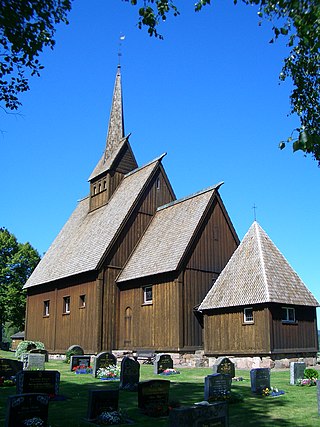
Høyjord Stave Church is a parish church of the Church of Norway in Sandefjord Municipality in Vestfold county, Norway. It is located in the village of Høyjord. It is the church for the Høyjord parish which is part of the Sandefjord prosti (deanery) in the Diocese of Tunsberg. The brown, wooden church was built in a stave church design during the late 12th century using plans drawn up by an unknown architect. The church seats about 150 people.

Undredal Stave Church is a parish church of the Church of Norway in Aurland Municipality in Vestland county, Norway. It is located in the village of Undredal, on the shore of the Aurlandsfjorden. It is the church for the Undredal parish which is part of the Sogn prosti (deanery) in the Diocese of Bjørgvin. The white, wooden church was built in a stave church style around the year 1147.

Eidsborg Stave Church is a parish church of the Church of Norway in Tokke Municipality in Telemark county, Norway. It is located in the village of Eidsborg. It is one of the churches for the Eidsborg, Mo, og Skafså parish which is part of the Øvre Telemark prosti (deanery) in the Diocese of Agder og Telemark. The brown, wooden stave church was built in a long church design around the year 1250 using plans drawn up by an unknown architect. The church seats about 70 people.

Røldal Stave Church is a parish church of the Church of Norway in Ullensvang Municipality in Vestland county, Norway. It is located in the village of Røldal. It is the church for the Røldal parish which is part of the Hardanger og Voss prosti (deanery) in the Diocese of Bjørgvin. The brown, wooden stave church was built in around the year 1250 using designs by an unknown architect. The church seats about 130 people and is built in a long church design. The church is a preserved historic museum, but it is still a regularly-used parish church that holds regularly scheduled worship services twice a month.

Reinli Stave Church is a preserved parish church of the Church of Norway in Sør-Aurdal Municipality in Innlandet county, Norway. It is located in the village of Reinli. It is the former church for the Reinli parish which is part of the Valdres prosti (deanery) in the Diocese of Hamar. The brown, wooden church was built in a long church design around the year 1300 using plans drawn up by an unknown architect. The church seats about 70 people.

Lomen Stave Church is a stave church of the Church of Norway in Vestre Slidre Municipality in Innlandet county, Norway. It is located in the village of Lomen. It was formerly the church for the Lomen parish which is part of the Valdres prosti (deanery) in the Diocese of Hamar. The brown, wooden church was built in a long church design around the year 1192 using plans drawn up by an unknown architect. The church seats about 150 people.

Høre Stave Church is a parish church of the Church of Norway in Vang Municipality in Innlandet county, Norway. It is located in the village of Kvien. It is the church for the Høre parish which is part of the Valdres prosti (deanery) in the Diocese of Hamar. The brown, wooden church was built in a long church design around the year 1179 using plans drawn up by an unknown architect. The church seats about 170 people.
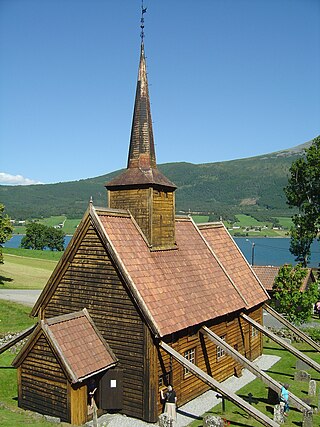
Rødven Stave Church is a former parish church of the Church of Norway in Rauma Municipality in Møre og Romsdal county, Norway. The stave church is located in the village of Rødven. It was a church in the Eid og Holm parish which is part of the Indre Romsdal prosti (deanery) in the Diocese of Møre. The brown, wooden church was built in a long church design during the 12th century by an unknown architect. The church seats about 100 people.

Hedalen Stave Church is a parish church of the Church of Norway in Sør-Aurdal Municipality in Innlandet county, Norway. The stave church is located in the Hedalen valley. It is the church for the Hedalen parish which is part of the Valdres prosti (deanery) in the Diocese of Hamar. The brown, wooden stave church was built in a cruciform design around the year 1160 using plans drawn up by an unknown architect. The church seats about 210 people.
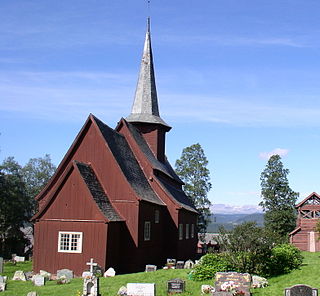
Hegge Stave Church is a 13th-century stave church in Norway. It is a parish church of the Church of Norway in Øystre Slidre Municipality in Innlandet county. It is located in the village of Hegge. It is the church for the Hegge parish which is part of the Valdres prosti (deanery) in the Diocese of Hamar. The brown, wooden church was built in a long church design around the year 1216 using plans drawn up by an unknown architect. The church seats about 150 people.

Arnafjord Church is a parish church of the Church of Norway in Vik Municipality in Vestland county, Norway. It is located in the village of Nese, along the Arnafjorden. It is the church for the Arnafjord parish which is part of the Sogn prosti (deanery) in the Diocese of Bjørgvin. The white, wooden church was built in a long church design in 1880. The master builder John Gjertsen from Sogndal made the designs, while builder Anders Korsvold was responsible for the construction. The church seats about 180 people.
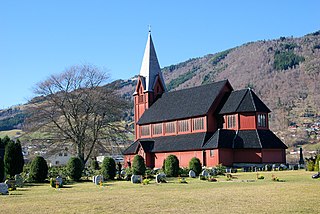
Stedje Church is a parish church of the Church of Norway in Sogndal Municipality in Vestland county, Norway. It is located in the village of Sogndalsfjøra, near the shore of the Sogndalsfjorden. It is the church for the Stedje parish which is part of the Sogn prosti (deanery) in the Diocese of Bjørgvin. The red, wooden church was built in a long church design in 1867 using plans drawn up by the architect Christian Christie. The church seats about 400 people.

Flåm Church is a parish church of the Church of Norway in Aurland Municipality in Vestland county, Norway. It is located in the village of Flåm. It is the church for the Flåm parish which is part of the Sogn prosti (deanery) in the Diocese of Bjørgvin. The brown, wooden church was built in a long church design in 1670 by master builder Magne Essen using designs by an unknown architect. The church seats about 160 people.





